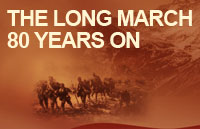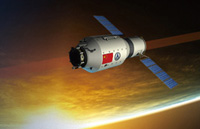The Silk Freeway
By Paul Ransom (chinadaily.com.cn) Updated: 2013-06-14 09:01You are welcome to share your China stories with chinadaily.com.cn
As Australia and China get set to extend trade and political ties, the relationship between the two countries is quietly but quickly evolving away from the megaphone of the media spotlight.
In the forty years since diplomatic relations between Canberra and Beijing were formally established, the ‘China/Australia relationship’ has been carefully nurtured in the twin stratospheres of regional diplomacy and international finance. As the closest quarry to China, Australia has found itself in a unique and profitable geographic and cultural position as supplier of raw materials and potential East/West cultural matchmaker.
However, beneath the lurid glare of mining booms and Mandarin speaking PMs, the strands of connection between Australia and China are being tended to by the many thousands of people living, working and studying in the middle of the cross cultural Ven diagram.
Here in Melbourne, where the roots of the local Chinese community extend back to the gold rush days of the 1850s, the presence of China is highly visible, from the dragon heads of Chinatown to the plane loads of young Chinese students arriving every semester. At this level the much vaunted Sino/Oz relationship is realised in smaller and more personal detail.
According to David Willey, a freelance business and investment consultant, things have certainly changed since his days selling local dairy products into the China market. “What I’m seeing now is Australians and Chinese getting comfortable together and saying, ‘okay, we have some different perspectives but there’s also some common ground’.”
|
 |
| Paul Ransom [Photo provided by the author] |
If indeed it is China’s three hundred million under thirties who will shape East/West dialogue in the coming years, then young women like 22-year-old Meng Lin may well be in the vanguard of a monumental, demographic driven attitude shift. Arriving in Melbourne alone at age sixteen, she has grown up straddling two cultures.
However, after six years inMelbourne, shenow voices the oft cited truism that China’s young people are increasingly Westward looking. “I think a lot of Chinese like to learn about Western culture because it’s different; and people are curious about something that’s new,” she says simply. “The one thing I really like about Western culture is the personal freedom and in the future it’s what I will be teaching my children.”
Western liberal individualism and its associated material goods are certainly a big lure for people used to more rigid cultural and political structures. American born, St Kilda based visual artist Robert Davis, who lived and taught in China for much of the last decade,agrees. “Freedom of thought, luxury goods, ownership of property, that whole lifestyle that they’ve seen on television, that’s what was given to them when the markets opened.”
For Davis, who was based in Shanghai for ten years, young China will almost certainly challenge the old order, much in the same way Baby Boomers did in the West. “An artist friend of mine over there said, ‘imagine if you got Disneyland, Picasso and 7/11 all at the same time’. That’s what it’s like for Chinese kids these days.”
If this anecdotal evidence plays out more broadly the China/Australia relationship will likely expand beyond the boardrooms of mining monoliths and the tabletops of cheap dumpling joints to encompass much more direct and personal experience.
Graphic designer Eric Huang could well be a poster boy for this shift. He came to Australia ten years ago from Taiwan to study multimedia and has now settled in Melbourne with his wife and four year old, Australian born daughter. “Australia is very accepting, very multicultural. That’s why I didn’t go to America or Europe, because here I am accepted for my skills.”
According to Huang though, our multicultural paradise is not without its black spots. “My impression is that most Australians think all Chinese are the same. In fact some of my Western friends say, ‘we thought you were all the same, all just Asians, cos you all look the same’. But y’know, in a way, I understand that because I used to think that all Western people looked the same.”
Relationships between countries are often abstract; merely political or economic constructions. Down on the ground, entrenched suspicions and stereotypes remain, even if they are papered over by fusion food and friendly progressives. Tabloid frothing about Asian invasions and selling the farm to China keep the yellow peril alive. “When I was in my own country I had the same feeling,” Eric Huang admits.“There were all these Vietnamese coming in and taking all the jobs and, y’know, people thought they were taking over. They weren’t but that’s what we thought. I think in Australia it’s the same thing.”
One those Vietnamese, Stan Chang, arrived in Australia in 1980 as part of the wave of post-Vietnam War refugees. An ethnic Chinese, he is now President of the Chinese Authors & Poets Society of Victoria and a spokesperson for the Springvale Asian Business Association.
His experience of the Sino/Oz relationship is very much that of the immigrant trying to deal with language and cultural barriers. Although he now regards Australia as very China friendly he still sounds a warning note. “Today it’s happening to the Muslims,” he says of the media tarring his own community once experienced. “It’s all the same old stories, just with a different migrant community.”
As ever, the coalface of international relations is in the suburbs of our apparently global village. For Stan Chang, geo-political chatter and media musing (like this) are perhaps just a symptom of impatience. “When you take in migrants you know you’re going to have problems at first, with language and culture and so on but the real benefit is in the future. It’s the second generation, the kids and grandkids that really make it work. And that’s what’s happening in our community. For our kids, Australia is their motherland.”
Eric Huang is quick to reflect this experience. “My mum always tells me I should come home and I tell her I already am. Plus, my daughter was born in Australia. She’s an Aussie,” he states.
However, for all the talk of China moving west, the onus is surely on the West to embrace China at a level deeper than dim sims and dragon parades. As business consultant David Willey notes, “The mark of any relationship is the comfort to confide in the other; and I’m not sure that we in Australia, at least at the political level, are comfortable enough to confide in China. If you measure the relationship in dollars and cents you have to ask how it will fare when China finds cheaper sources of coal.”
Paul Ransom is freelance writer, director and award winning filmmaker based in Melbourne, Australia. He currently works for a Chinese/Australian media company, Zhong Hua TV and writes regularly about music, dance and culture for a variety of publications. He also has a blog consisting entirely of love letters.
- Talks with Manila at early date expected
- Authorities stop illegal broadcasts
- More polluters punished under tougher regulation
- Respect, protect nature during development: Xi
- Wraps come off design of Mars probe
- 900 Malaysians check out China's high-speed rail
- Chinese 'Red Notice' fugitive hit with largest forfeiture in NZ
- Li: Infrastructure boost planned to aid rural Jiangxi
- Rules detailed for social organizations
- School to pay salary of teacher who died










